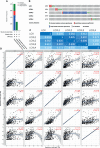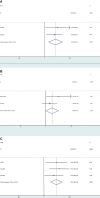Diagnostic Value, Prognostic Value, and Immune Infiltration of LOX Family Members in Liver Cancer: Bioinformatic Analysis
- PMID: 35311155
- PMCID: PMC8931681
- DOI: 10.3389/fonc.2022.843880
Diagnostic Value, Prognostic Value, and Immune Infiltration of LOX Family Members in Liver Cancer: Bioinformatic Analysis
Abstract
Background: Liver cancer (LC) is well known for its prevalence as well as its poor prognosis. The aberrant expression of lysyl oxidase (LOX) family is associated with liver cancer, but their function and prognostic value in LC remain largely unclear. This study aimed to explore the function and prognostic value of LOX family in LC through bioinformatics analysis and meta-analysis.
Results: The expression levels of all LOX family members were significantly increased in LC. Area under the receiver operating characteristic curve (AUC) of LOXL2 was 0.946 with positive predictive value (PPV) of 0.994. LOX and LOXL3 were correlated with worse prognosis. Meta-analysis also validated effect of LOX on prognosis. Nomogram of these two genes and other predictors was also plotted. There was insufficient data from original studies to conduct meta-analysis on LOXL3. The functions of LOX family members in LC were mostly involved in extracellular and functions and structures. The expressions of LOX family members strongly correlated with various immune infiltrating cells and immunomodulators in LC.
Conclusions: For LC patients, LOXL2 may be a potential diagnostic biomarker, while LOX and LOXL3 have potential prognostic and therapeutic values. Positive correlation between LOX family and infiltration of various immune cells and immunomodulators suggests the need for exploration of their roles in the tumor microenvironment and for potential immunotherapeutic to target LOX family proteins.
Keywords: bioinformatic analysis; immune infiltration; liver cancer; lysyl oxidase; nomogram; prognostic value; receiver operating curve.
Copyright © 2022 Sun, Ma, Chen, Kim, Kailas, Wang, Gu, Chen, Tuason, Bhan, Manem, Huang, Cheng, Zhou, Zhou and Zhu.
Conflict of interest statement
The authors declare that the research was conducted in the absence of any commercial or financial relationships that could be construed as a potential conflict of interest.
Figures













Similar articles
-
Comprehensive Analysis on Prognosis and Immune Infiltration of Lysyl Oxidase Family Members in Pancreatic Adenocarcinoma With Experimental Verification.Front Mol Biosci. 2022 Apr 1;9:778857. doi: 10.3389/fmolb.2022.778857. eCollection 2022. Front Mol Biosci. 2022. PMID: 35433829 Free PMC article.
-
The prognostic value of the lysyl oxidase family in ovarian cancer.J Clin Lab Anal. 2020 Dec;34(12):e23538. doi: 10.1002/jcla.23538. Epub 2020 Oct 15. J Clin Lab Anal. 2020. PMID: 33058284 Free PMC article.
-
Systematic Analysis of Expression and Prognostic Values of Lysyl Oxidase Family in Gastric Cancer.Front Genet. 2022 Jan 20;12:760534. doi: 10.3389/fgene.2021.760534. eCollection 2021. Front Genet. 2022. PMID: 35126449 Free PMC article.
-
Lysyl Oxidase (LOX) Family Members: Rationale and Their Potential as Therapeutic Targets for Liver Fibrosis.Hepatology. 2020 Aug;72(2):729-741. doi: 10.1002/hep.31236. Hepatology. 2020. PMID: 32176358 Review.
-
Evolving roles of lysyl oxidase family in tumorigenesis and cancer therapy.Pharmacol Ther. 2020 Nov;215:107633. doi: 10.1016/j.pharmthera.2020.107633. Epub 2020 Jul 18. Pharmacol Ther. 2020. PMID: 32693113 Review.
Cited by
-
Development of a prognostic prediction model based on a combined multi-omics analysis of head and neck squamous cell carcinoma cell pyroptosis-related genes.Front Genet. 2022 Sep 29;13:981222. doi: 10.3389/fgene.2022.981222. eCollection 2022. Front Genet. 2022. PMID: 36246601 Free PMC article.
-
Ferroptosis-associated gene CISD2 suppresses colon cancer development by regulating tumor immune microenvironment.PeerJ. 2023 Jun 5;11:e15476. doi: 10.7717/peerj.15476. eCollection 2023. PeerJ. 2023. PMID: 37304867 Free PMC article.
-
Integrated multi-omics analysis reveals the immunotherapeutic significance of tumor cells with high FN1 expression in ovarian cancer.Front Mol Biosci. 2025 Jun 19;12:1611964. doi: 10.3389/fmolb.2025.1611964. eCollection 2025. Front Mol Biosci. 2025. PMID: 40612060 Free PMC article.
-
Cervical Cancer Imaging Features Associated With ADRB1 as a Risk Factor for Cerebral Neurovascular Metastases.Front Neurol. 2022 Jul 12;13:905761. doi: 10.3389/fneur.2022.905761. eCollection 2022. Front Neurol. 2022. PMID: 35903112 Free PMC article.
-
Prognostic microRNAs associated with phosphoserine aminotransferase 1 in gastric cancer as markers of bone metastasis.Front Genet. 2022 Aug 19;13:959684. doi: 10.3389/fgene.2022.959684. eCollection 2022. Front Genet. 2022. PMID: 36061202 Free PMC article.
References
LinkOut - more resources
Full Text Sources

